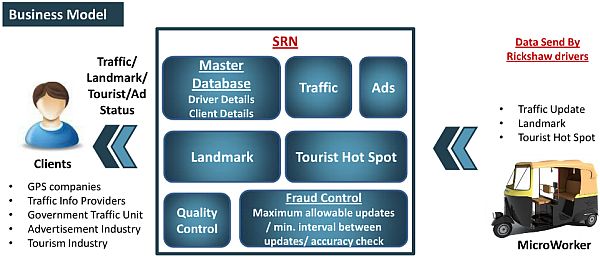Imagine recycling, reusing, part-time income, advertising, tourism boost and traffic decongestion being achieved through a single app! That is what India’s Aadhar Bhalinge has created as the winning entry for m2Work, an online challenge seeking champion ideas to exploit the job-creating potential of mobile phones.
Aadhar came out as a clean victor in this World Bank sponsored competition and his idea of a Smart Rickshaw Network or SRN scored over 938 other ideas to win the US$ 20,000 grand prize. He presented a mechanism and tool that majorly help to recycle mobile phones and add to the income of auto rickshaw drivers in developing countries.

The second place was awarded to a ‘MicroForester’ app and the third to ‘Mobile Diagnostics’. But those are different stories altogether.
So what exactly is SRN all about?
The eco-friendly venture is about creating a network of entrepreneurs, auto rickshaw drivers in this case, through franchising and empowering them with technology to provide useful information for a supplemental earning. The SRN network will procure used smartphones (which would otherwise have ended up in landfills) and load the app on to them. It will then enlist interested drivers and train them in the technology.
Auto rickshaw drivers in developing countries waste a lot of productive time in traffic jams. Such free time can now be utilized to earn them some extra cash. The SRN-recycled smartphone is fixed on a stand by the driver’s side. In the free time, the driver enters updates on traffic, landmarks and tourist-hotspots of the particular location they are present at. The app conveys this information to the SRN network.
The Network now processes that data and sorts it. In turn, it sends the traffic updates to the Government traffic units and other interested parties like INRIX and NAVTEQ. These updates can also be shared with other auto rickshaw drivers so that they can make adjustments in the routes they take. The tourism industry receives the other updates. The payment received for these services are disbursed to the auto rickshaw drivers who are thrilled at this supplementary income. The Network performs three important roles:
- Doing a quality check on the received data before sanctioning it for processing.
- Processing data to create information.
- Controlling fraud
And now, here is the part where this venture turns into an ‘ad’venture! The app also allows the driver to make a choice of the kind of ad he would like to sport in his vehicle. The relevant advertiser is notified and the driver earns some more!
What about driving safety then?
To ensure that the greed for money does not overpower the need for safety, some interesting measures can be put in place. Since smartphones are being used in the operation, a ‘Safe Mode’ can be built into the driver’s app wherein beyond a certain speed, the app can only be controlled by audio. In fact, it can be made such that the app does not work beyond a certain speed. Training of the drivers will also play a major role in safety. The fraud control mechanism is designed to prevent the drivers from being in a rush to dispatch as many sms in order to earn more. Along these lines, a driver rating system can also be developed to punish errant drivers.
Taking India for the pilot study, the plan could be to ensure that the 6 lakhs-odd auto rickshaws and 100 lakhs-odd cycle rickshaws in the 10 major cities come under the Network. The app could be introduced in one city, say Bengaluru, to study its effectiveness and understand potential problems. The cost works out to $8 million annually per city which is much less compared to $150 million installation costs and the $17 million annual maintenance costs of the Advanced Traffic Systems.
Apart from being economical, manual data-sourcing through these rickshaw drivers who act as microworkers will also be more accurate compared to the fixed-sensor technologies or automatic detection. Automated detection technologies also require the user (rickshaw driver) to invest in high-end specialized devices instead of a recycled smartphone. Again, automated detection based on vehicular speeds face the problem or incorrect treatment in cases where vehicles are slowed down due to weather conditions, slippery roads etc.
The greatest risk of the app-system however is that it is completely based on human perception and judgement. Whatever be the training, differenciating between medium/ high traffic and tourist hot spot will depend on the mood and judgement of the driver concerned. However, this does not take away anything from the ingenious idea which cannot be judged until it is actually applied in a real-life situation.
